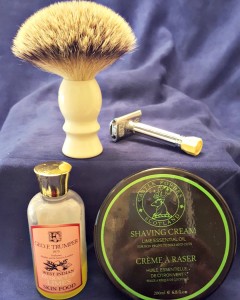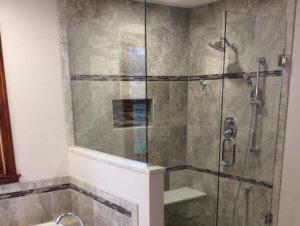A good shave comes down to three things: prep, equipment (hardware and software) and technique.
Equipment

As for equipment, we are living through a “Golden Age for Shaving.” There really is no reason to be stuck using inferior hardware (razor, blades/cartridges, and brushes) or software (soap, cream, aftershave balm). Sharpologist in particular produces stellar recommendations and top ten lists for all of the above.
There are excellent equipment choices to match any budget. For example, I use Persona Blue Med-prep blades, which costs 30 cents/blade. Unlike, say 20 years ago, one can literally walk into any upscale mall and purchase top quality equipment, while the offerings at the big box stores also continue to improve.
Technique can be boiled down to: don’t press down (for DE shavers); and always shave your first pass with the grain. Everything else is refinement.
How many additional passes, if any, is a matter of personal preference. The key observation is that shaving stubble that is too short leads to irritation. So shave really close (3 passes) if that translates into shaving every other day, or shave just close enough (1-2 passes) for those unlucky souls who need to shave every day.
I, sadly enough, fall into the latter category. However, one of my personal refinements is that I don’t treat all parts of my face the same: I practice facial discrimination! The sides of my neck get a single pass, while my cheeks and jaw get two passes–with and against. Finally, my upper lip, lower lip, chin, and below the chin down to my adam’s apple get two passes: with and across, with a little against the grain touch up for any remaining rough spots.
When I’m in a hurry, I skip the additional passes. While my face does not feel all that smooth to my hand, I do however look presentable according to my reflection in the mirror.
Prep

Shave prep is different. One can’t purchase a better performing “prep” like one can for shaving cream. Furthermore, unlike technique, practice and refinement isn’t going to help either. Either you have properly prepared your face to be scrapped by a razor sharp edge of metal, or you haven’t!
There is a simple test to learn if you were successful with your skin preparation routine: your shave should be an audible only experience. With good equipment and technique, when you run the razor in a short stroke across your face it should feel as if you forgot to load a blade. Oddly enough, good prep can lead novices to over shaving – it did not feel as if any hair was cut, so they’ll run the blade over the same spot again, and again, and again.
There are a lot of suggestions for achieving this holy grail; shave after a hot shower, use a wet microwaved towel, avoid shaving right after waking up (yes, in addition to bed-hair, there is bed-face: facial swelling that can occur depending on sleep position), don’t eat before shaving (due to the small increase in facial blood circulation from eating), use a pre-shave oil, avoid shaving at night, don’t shave at night, etc… You get the idea.
Sadly, I can not offer clarity on the scientifically proven best method for how to both soften the skin and bloat one’s stubble with moisture. Instead, I wish to further muddy the waters by offering yet another approach: shaving in the shower.
Shower Shaving

Let me answer the obvious question straightaway: Yes, there is a difference between shaving in the shower and shaving immediately upon exiting the shower: time and colder air (especially in the winter). I can get a perfectly fine shave, post-shower. However, it is nothing like my shaves in a steamy hot shower.
Evidently, the time it takes to dry my body, sans-face, load my brush, and create lather makes a difference, as does steamy air in which one shower shaves in. Nicks, weepers, irritation patches are all significantly reduced/eliminated with my shower shaves.
Before getting to some of the other advantages of shower shaving, let me address the only real downside: hot water consumption. By definition, you’ve just extended your showering time by the time it takes to shave. I’m a homeowner, which means I pay an increased water bill and energy bill for the privilege of shower shaving. This may be something you’ll need to take into consideration. For me, my house is equipped with an on-demand hot water heater and a low flow shower head. So, I’m not as bad a water waster as you might have first thought. With the on-demand water heater, there’s no worry that the other members of the house will run out of hot water.
On to the three other advantages besides a smooth, moist, blood-reduced (free) shave.
- Cleanup’s a snap! No more sink counter, or if you’re like me – floor from sloppy face rinsing, to wipe dry, or stubble and soap ring to rinse from the sink.
- You can lather like a madman! In the spirit of singing as if no one is hearing, or dancing as if nobody’s watching, you can channel your inner Sweeney Todd and lather with abandon – no flying lather to later clean up.
- Finally, while your shower time has increased, your total bathroom time will shorten. If that’s not going to make you a hero for those not living alone, then nothing will!

My shower head has a flow restrictor, which can slow the flow to a dribble—or completely stop it. So I would argue I actually use LESS water by shaving in the shower than showering and shaving in the sink.
Good for you! Next time I replace my shower head, I’ll have to look into doing this.
Ha, I actually *removed* the flow restrictor on my newest shower head. 🙂
I’ve removed them from some shower heads in the past. But the one I have now is so easy to use (one hand/one finger operation) and doesn’t impact the regular flow at all, when fully opened.
Comments are closed.